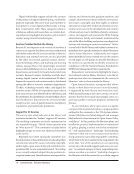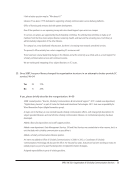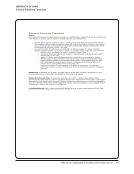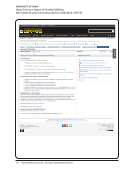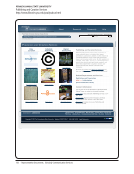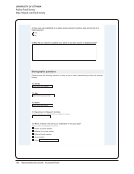SPEC Kit 332: Organization of Scholarly Communication Services · 13
two have 10 to 25 full-time liaison librarians. Thirteen
individuals have copyright, licensing, or publishing
training or a law degree. The amount of time that 30 of
these individuals devote to leading SC efforts ranges
from 5% to 100%, with an average of 43%. The dean
spent the smallest amount of time on SC leadership.
The table below shows the distribution of time across
these positions.
%Time N %
25% 11 37
25–50% 10 33
75–100% 9 30
Library Team, Committee, or Task Force
The nine teams that lead SC efforts are made up of
representatives from a variety of departments includ-
ing collections/technical services, research/instruc-
tion (six teams each), branch/regional libraries, digital
initiatives (four teams each), library administration,
special collections/archives (two teams each), and li-
brary IT. The number of members ranges from three
to 12, with an average of eight. Five teams report they
have full-time members. Most of the teams report to
the library director or a management group. The table
below shows the number of members across the nine
teams.
Members N %
3 3 33
9–10 4 44
≥10 2 22
No Single Individual or Group
One respondent described their institution as a decen-
tralized organization, and while there is a library-led
Scholarly Communications Group, “other [institu-
tional] libraries, academic units, and support units can
offer their own SC services.”
Scholarly Communication Services in the Library
The survey asked whether four broad categories of
SC services—campus-based publishing, education
and outreach activities, hosting and managing digital
content, and support for research, publishing, and cre-
ative works—were offered by the library, elsewhere in
the institution, or not offered. The responses show that
educational activities continue to be a defining char-
acteristic of libraries’ SC roles that was first reported
in SPEC Kit 299 Scholarly Communication Education
Initiatives.
On average, 89% of respondents offer one or more
of the seven activities in the education and outreach
category. Services to “advise and educate authors
about copyright, retaining rights, etc.” are the only
ones offered by all the responding libraries. It is no-
table that librarians very often serve as copyright
educators even though only about a quarter of library
SC leaders have law degrees or have participated in
some form of copyright training. Seventy-six per-
cent of the responding libraries offer services related
to hosting and managing digital content, 71% offer
campus-based publishing services, and 55% provide
the services associated with supporting research,
publishing, and creative works.
A deeper analysis of the responses suggests that
three different categories would more accurately de-
scribe the library services currently offered: 1) liaising,
outreach, and support for author rights, 2) hosting and
preserving digital content, and 3) digital scholarship
support. With the specific services categorized in this
way, the percentages change: 75% of the libraries offer
liaison, outreach, and author rights support 75% host
and preserve digital content and 68% provide digital
scholarship support.
Liaising, outreach, and support for author rights
activities include consultations with researchers as au-
thors and rights holders (advising on publications and
legal matters or planning events to increase scholars’
awareness of scholarly publishing issues) and manag-
ing outreach requests usually associated with liaison
librarian duties, which often support authorship (e.g.,
fielding requests for purchases or subscriptions or
assisting with literature reviews).
Hosting and preserving digital content activities
relate to accessing and maintaining institutional re-
search data and content, storing and preserving insti-
tutional data and content, and sharing or publishing
institutional data and content, particularly via insti-
tutional technologies (e.g., institutional repositories).
two have 10 to 25 full-time liaison librarians. Thirteen
individuals have copyright, licensing, or publishing
training or a law degree. The amount of time that 30 of
these individuals devote to leading SC efforts ranges
from 5% to 100%, with an average of 43%. The dean
spent the smallest amount of time on SC leadership.
The table below shows the distribution of time across
these positions.
%Time N %
25% 11 37
25–50% 10 33
75–100% 9 30
Library Team, Committee, or Task Force
The nine teams that lead SC efforts are made up of
representatives from a variety of departments includ-
ing collections/technical services, research/instruc-
tion (six teams each), branch/regional libraries, digital
initiatives (four teams each), library administration,
special collections/archives (two teams each), and li-
brary IT. The number of members ranges from three
to 12, with an average of eight. Five teams report they
have full-time members. Most of the teams report to
the library director or a management group. The table
below shows the number of members across the nine
teams.
Members N %
3 3 33
9–10 4 44
≥10 2 22
No Single Individual or Group
One respondent described their institution as a decen-
tralized organization, and while there is a library-led
Scholarly Communications Group, “other [institu-
tional] libraries, academic units, and support units can
offer their own SC services.”
Scholarly Communication Services in the Library
The survey asked whether four broad categories of
SC services—campus-based publishing, education
and outreach activities, hosting and managing digital
content, and support for research, publishing, and cre-
ative works—were offered by the library, elsewhere in
the institution, or not offered. The responses show that
educational activities continue to be a defining char-
acteristic of libraries’ SC roles that was first reported
in SPEC Kit 299 Scholarly Communication Education
Initiatives.
On average, 89% of respondents offer one or more
of the seven activities in the education and outreach
category. Services to “advise and educate authors
about copyright, retaining rights, etc.” are the only
ones offered by all the responding libraries. It is no-
table that librarians very often serve as copyright
educators even though only about a quarter of library
SC leaders have law degrees or have participated in
some form of copyright training. Seventy-six per-
cent of the responding libraries offer services related
to hosting and managing digital content, 71% offer
campus-based publishing services, and 55% provide
the services associated with supporting research,
publishing, and creative works.
A deeper analysis of the responses suggests that
three different categories would more accurately de-
scribe the library services currently offered: 1) liaising,
outreach, and support for author rights, 2) hosting and
preserving digital content, and 3) digital scholarship
support. With the specific services categorized in this
way, the percentages change: 75% of the libraries offer
liaison, outreach, and author rights support 75% host
and preserve digital content and 68% provide digital
scholarship support.
Liaising, outreach, and support for author rights
activities include consultations with researchers as au-
thors and rights holders (advising on publications and
legal matters or planning events to increase scholars’
awareness of scholarly publishing issues) and manag-
ing outreach requests usually associated with liaison
librarian duties, which often support authorship (e.g.,
fielding requests for purchases or subscriptions or
assisting with literature reviews).
Hosting and preserving digital content activities
relate to accessing and maintaining institutional re-
search data and content, storing and preserving insti-
tutional data and content, and sharing or publishing
institutional data and content, particularly via insti-
tutional technologies (e.g., institutional repositories).














